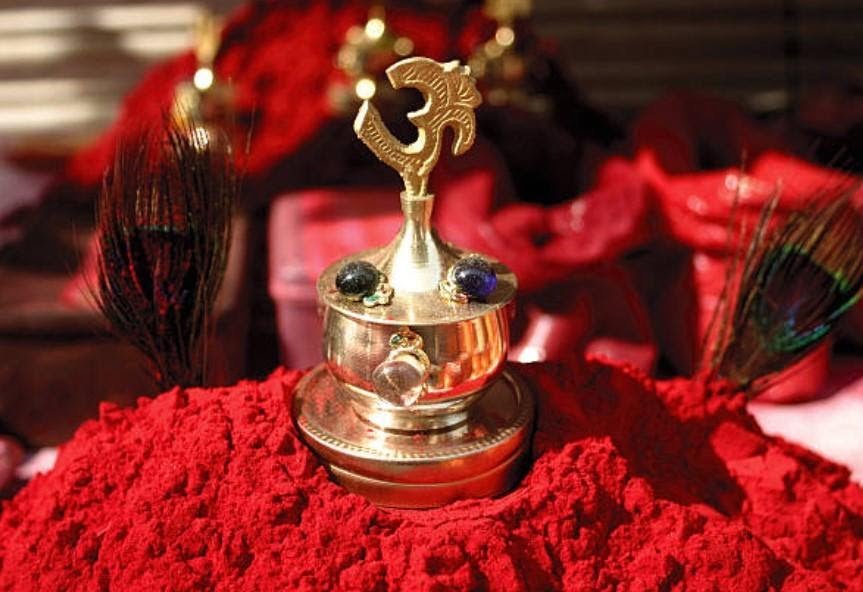Kumkum is of immense importance for Hindus. Especially for Hindu women, Kumkum importance extends to immense religious and social significance. In the olden days, both Hindu men and women gave importance to Kumkum and equally applied Kumkum as a part of daily rituals. If one inspects why Hindus wear Kumkum and the importance of Kumkum, many scientific and religious secrets emerge. Through this post, let us decode the importance of Kumkum and the science behind why Hindus wear Kumkum.
Quick Navigation
How is Kumkum made?
Kumkum is a sacred powder of religious importance to Hindus. It is made from pure turmeric and limestone in the ratio 95:5. Sometimes, a little ghee and pure camphor are added during the preparation of Kumkum.
Organic and authentic Kumkum is untouched by hand. It is specially prepared by chanting mantras throughout the process of its preparation. As the process proceeds, the powder starts losing the smell of turmeric and attains a distinctly strong smell that one can even notice from a long distance.
Traditional families still have their secret formula for making Kumkum, though the practice is vanishing gradually. Those who want to attain the comprehensive benefits of wearing Kumkum should opt for organic and best quality Kumkum from trusted sources rather than relying on chemical-laden artificial Kumkum.
India vs Bharat: The Significance of the Name Bharat
Reason for wearing Kumkum on the Forehead
The primary reason to keep Kumkum on the forehead is to soothe and activate the Ajna chakra (pituitary and pineal glands) present slightly above and between the eyebrows.
When one presses the middle part of the eyebrows while applying Kumkum, it energizes them enormously. Applying Kumkum makes it easy to attract spiritual vibrations that are present in nature.
Kumkum opens one Ajna chakra and prevents energy loss, thus filling them with refreshing and positive energy throughout the day.
Health Benefits of Wearing Kumkum
Kumkum, being primarily made of turmeric, contains earthly properties. It helps one to stay grounded and patient, away from ego and anger.
Kumkum attains red due to the mix of lime with turmeric. Red is a color of divine power according to Hinduism. It depicts the Shakti of Goddess Durga. It also represents the energy hidden in all living beings. Thus, the wearing of Kumkum on the Ajna chakra energizes the life force hidden in the humans.
The energy present in the Kumkum prevents the entry of negative energies into one’s body. It attracts only the positive vibrations and purifies one’s air body and mental energy.
According to ancient beliefs, women who wore Kumkum enjoyed high levels of patience and stamina. It is because of its medicinal and healing properties and the soothing energies it imparts to the wearer. Thus, married women needed to wear Kumkum as they had to bear the endless domestic and social responsibilities.
Ayodhya Ram Mandir Temple Story
The Social Significance of Wearing Kumkum
Kumkum is a mark of matrimony for women in India. A woman with Kumkum is considered a mother for any other man except the husband.
Kumkum imparts a kind of dignity to those who wear it. A face looks complete and comprehensive with a red circular Kumkum in between the eyebrows on the forehead. Men who wear Kumkum are considered scholarly and respected for their knowledge. Even today, many male spiritual leaders never miss wearing Kumkum on their foreheads.
Primarily married women wear Kumkum on their forehead and in the parting of their hair. In some cultures, only married women wear Kumkum while unmarried girls don’t. In other cultures, there is not much distinction; both married and unmarried women wear Kumkum on the forehead.
But, applying Kumkum on the parting of their hair is only practiced by married women across any part of India. The Kumkum on the parting of a woman’s hair resembles the flow of life energy and red blood that is full of life.
Kumkum on a woman’s forehead symbolizes the husband’s longevity and good health. It is a tradition that the husband applies Kumkum on the forehead of a woman for the first time during their marriage. Later she does it daily. In some cultures, even the application of Kumkum by a man onto a woman’s forehead is a mark of their marriage.
When the husband dies, a woman wipes off the Kumkum on her forehead. And she never wears it again. Thus, a woman with no Kumkum on her forehead symbolizes widowhood according to Hinduism.
Significance of Kumkum According to Hinduism
As per Hinduism, Kumkum is considered the symbol of the rising sun. Adi Sankaracharya, in his book Soundaryalahari, explains the beauty of Kumkum on a woman’s forehead in this way:
tanotu kṣemaṃ naḥ tava
vadana saundaryalaharī
parīvāha-strotaḥ saraṇiriva sīmanta-saraṇiḥ ।
vahantī sindūraṃ prabala kabarī bhāratimira-
dviṣāṃ bṛndair bandī-kṛtamiva navīnārka kiraṇam ॥
तनोतु कृमं नं तवः
वदना सौंदर्यलहरि
परिवाह-स्त्रोतं सरशीरिव सिमंत-सरणी:।
वहंति सिंधीरां प्रबल कबरी भारतीमिरा-
द्विषां बंधैर बंदि-कृतमीव नवीनारका किरणम् ||
Meaning: Oh Mother, the Kumkum in the parting of your hair resembles the rising sun. May it protect us all the time and give us peace.
- Draupadi, the wife of Pandavas, erases her Kumkum to express her agony at the mishappenings occurring in the court due to the failure of Pandavas.
- In another story about Lord Sri Krishna, Radha turned Kumkum into a flame-like design and wore it on her forehead.
- Lalita Sahasranamam, the thousand names of Goddess Lalita Devi, mentions Kumkum in various instances. The Goddess is so fond of Kumkum for all the divine powers it is born with.
- In another instance from Ramayana, Maa Sita applies Sindoor on her hair parting. Noticing this, Lord Hanuman asks enthusiastically – why is she doing so? For this Sita Mata explains in very simple words to Hanuman, for she considers him as his son and a child. She says to Hanuman that – she wears Sindoor to ensure her husband’s longevity. Jumping with joy, Hanuman then starts applying Sindoor all over his body, considering it would make Lord Ram immortal. It is why we find Hanuman smeared with Sindoor in many places for he loves to wear it for Rama’s longevity.
- Applying Kumkum on the forehead implies victory too. It was a practice that Hindu queens and Rajmatas used to apply Kumkum on the forehead of Hindu kings while they were setting out on expeditions and wars.
- Even today, before tying Rakhi to a brother, sisters apply Kumkum to his forehead as a mark of divine protection.
- It is a social custom among Hindus to apply Kumkum on women’s forehead while inviting them to any functions, or they visit others’ homes.

Why is Kumkum Used in Puja?
Kumkum is one of the essential components for performing the puja of Goddess Durga. It evokes the Pranic energy and spreads Chaitanya waves effectively. Red Kumkum is a symbolic form of the energy hidden in Goddess Durga. Worshipping Durga mata with Kumkum, called Kumkumarchana, is a famous effective spiritual practice and is suggested to obtain respite from troubles.
The practice of applying Kumkum to each other, worshipping Goddess Durga with kumkum, and playing with Kumkum during Durga Puja is widely popular in West Bengal during Dasara celebrations.
Even in temples, it is a practice that the priest distributes Kumkum after the end of Archana or puja to the devotees. The reason behind this is – in temples, the positive vibrations are all-pervasive. Kumkum being highly spiritual in nature attracts the positive energies and holds in them.
When the priest performs the puja to the main deity with Kumkum, it attracts the divine vibrations of the deity. When the devotees wear such Kumkum even a pinch, it imparts them the holy vibes and thus helps in preventing negative energies.
Difference Between Kumkum and Sindoor
Though they look similar and are used interchangeably, there exists a subtle distinction between Kumkum and sindoor.
- Kumkum is dark and pure red. It is made of turmeric and limestone.
- Sindoor is reddish-orange. It is obtained by mixing cinnabar ( a mercuric compound) to attain the orange color.
Women in India wear Sindoor or Kumkum as per their cultural practices. Whatever it is – Sindoor or Kumkum – the reasons for wearing them remain the same.
How to Apply Kumkum on the Forehead?
To apply Kumkum on the forehead, take a bath, and wear clean clothes. Pray to God and take a small pinch using your middle finger and thumb. Make a dot a little above the mid of the eyebrows on your forehead by pressing the Kumkum with the middle finger. And you are all set to attract positive energies!
Why Indian Women Wear a Bindi?
Bindi is the modern form of matrimonial symbolism for Hindu women. It occupied the place of Kumkum that married women ought to wear.
Bindis are made of plastic. They only serve cosmetic purposes. They convey that a woman is married. However, they are devoid of the spiritual and health benefits that Kumkum imparts. Being made of plastic, Bindis close the Ajna chakra in contrast to the Kumkum that opens it and allows divine energies.
Thus, bindi is only for cosmetic purposes. To reap the comprehensive benefits of the Kumkum wearing tradition, women should wear organic Kumkum purchased from trusted sources.

